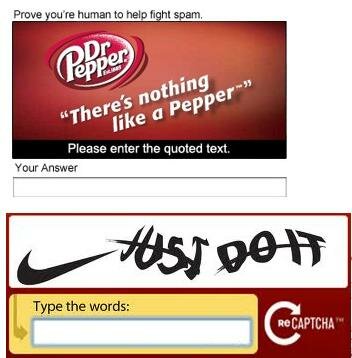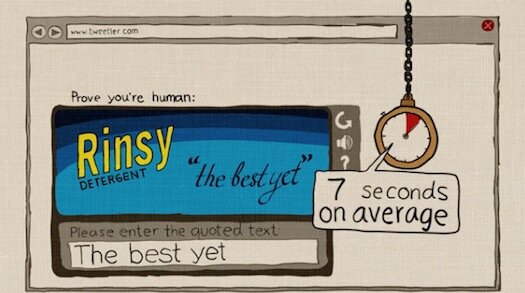features
Catching the TG through a Captcha!
05 Apr 2012
6 Comments
Captcha stands for “Completely Automated Public Turing test to tell Computers and Humans Apart.” It probably takes a sixth of a minute for a user to decipher a captcha and prove that they are not spam bots. Every day over 280 million captchas waste more than 800,000 hours of human attention.
Captchas are implemented to protect users from robot spam, but as computers get smarter, they become difficult for even the most humans among us. Often they are nearly impossible to discern, to the point where deciphering the words just becomes impossible.
 Of late, there has been an evolution of the concept of captcha advertisements where advertisers run ads in place of captchas and the user has to read or see that entire ad to solve that captcha. People are ever saying that it is crazy to watch and pay attention to the entire advertisement in order to fulfill the captcha box.
Of late, there has been an evolution of the concept of captcha advertisements where advertisers run ads in place of captchas and the user has to read or see that entire ad to solve that captcha. People are ever saying that it is crazy to watch and pay attention to the entire advertisement in order to fulfill the captcha box.
Besides the consumers, there is an angle of how marketers would react to this concept. This can be argued that such ad units are clearly a tactic, not a strategy, and therefore not worth much time at all for marketers to assess their value. At most, a brand manager who is running an awareness campaign online would expect that the media-buying agency is keeping an eye on the captcha ad space for really cheap CPMs.
India Digital Review quizzed some captcha advertisement service providers in India to discuss about the viability of the concept and how they see its future in India, especially when the current internet advertising scenario in India is dominated by search engine marketing and display advertisements.
 Ankit Gupta, Co-Founder, Innovese Technologies, which runs captcha advertising firm yoCaptcha was of the view that there is a fight for human attention which is not captured in an effective way by banners. “So, when there’s an unused space on the internet wasting so much of user attention daily and there’s a whole industry struggling to capture it, why not blend them together and come up with a powerful tool? This is why we came up with the concept of Captcha Advertising (yoCAPTCHA). Our captcha Ad-unit replaces the traditional difficult to read "warped text" captchas with a crisp and readable advertisement, and the user is now asked to answer a simple question based upon the advertisement. In this way the ad-message doesn't only receive a guaranteed user attention, but also user tends to remember the ad-message, making it a powerful tool for advertising,” Gupta explains.
Ankit Gupta, Co-Founder, Innovese Technologies, which runs captcha advertising firm yoCaptcha was of the view that there is a fight for human attention which is not captured in an effective way by banners. “So, when there’s an unused space on the internet wasting so much of user attention daily and there’s a whole industry struggling to capture it, why not blend them together and come up with a powerful tool? This is why we came up with the concept of Captcha Advertising (yoCAPTCHA). Our captcha Ad-unit replaces the traditional difficult to read "warped text" captchas with a crisp and readable advertisement, and the user is now asked to answer a simple question based upon the advertisement. In this way the ad-message doesn't only receive a guaranteed user attention, but also user tends to remember the ad-message, making it a powerful tool for advertising,” Gupta explains.
 Amit Mittal, Co-Founder, NLPCaptcha opined that the current internet display advertising is dominated by traditional banners and some kind of innovations like screen blockades, sliders, popups etc. But the problem is that there are a number of banners on any page hungry for user attention but nobody knows how many banners have been actually been noticed by the end user. They are turning into blind spots. The innovation like screen blockades does ensure better notability but they are a very irritating experience for the user so the publisher can’t run it on a daily basis and also there is a huge probability of the user closing it even before it loads properly. Hence, the problem of user attention is still not resolved.
Amit Mittal, Co-Founder, NLPCaptcha opined that the current internet display advertising is dominated by traditional banners and some kind of innovations like screen blockades, sliders, popups etc. But the problem is that there are a number of banners on any page hungry for user attention but nobody knows how many banners have been actually been noticed by the end user. They are turning into blind spots. The innovation like screen blockades does ensure better notability but they are a very irritating experience for the user so the publisher can’t run it on a daily basis and also there is a huge probability of the user closing it even before it loads properly. Hence, the problem of user attention is still not resolved.
“On the other hand, a person in his routine internet browsing, spends focused 8-10 seconds every time he fills in a captcha to prove that he is a human and not some automated bots - reading the distorted characters in the captcha and then writing it down. So captcha advertising helps all the three parties involved—Publisher, with a new premium inventory to generate revenues. User gets a beautiful banner which gives some kind of information rather than ugly distorted characters and advertisers get focused eyeballs. A study by Wharton claims that if we compare same creative used in traditional banner versus captcha advertisement, the brand recall increases by 111 per cent and message recall by 1200 per cent,” Mittal added.
Another point of view that emerges is that captcha is preferably used to counter spammers, especially in the comments section. But the number of people commenting on the piece is much less than the number of people actually reading the piece. How would captcha ads help in this?
Answering this query, Amit Mittal of NLPCaptcha said that the usage of captcha is not limited to comments, they are used in registrations, polls, contests, downloads, transactions etc. In total, around 500 million captchas per month are being used in India and there are 100 million internet users, so an average each person uses 5 captchas every month. “Though the volume is low as compared to banners but the USP is 100 per cent attention. A person might see hundreds of banners and notice only a couple of them but if he sees 5 captchas, he is bound to see it, read it and write it to remember it. Just for example. Times of India did “Vote for Anna” campaign in which 5 million people voted in just 2 weeks. All 5 million people did fill in a captcha to vote. So though contests/ polls etc are seasonal but the volumes and reach is very high,” Mittal added.
Commenting on the same, Ankit Gupta of Innovese said, “Captchas are essentially used to protect any open web form on the internet. These can be forms at Sign-ups, Forget Passwords, Contact Us, Forums, Blog Comments etc. We are majorly targeting high traffic websites which get a huge amount of traffic and also users interacting with the forms. Regular publishers benefit from it because captcha-ads not only serve them as an extra source of revenue but also make the whole experience of solving captcha easier for the user.”
When asked what would be the measuring metric for these captcha ads, Amit Mittal said that they have coined a new metrics for charging the advertisers i.e. Cost-Per-Recall (CPR) which we have trademarked. “We charge the advertiser only for the captchas used and not for those when captcha is displayed but not used. So, the advertiser is sure that he is paying only when the person has actually seen the ad and written his brand message. The Click through rates we are getting are unheard of in the industry, for some of the campaigns the CTR rates have been as high as 65 per cent and on an average around 40 per cent. This means that out of every 100 people using the Captcha, 40 people on an average click on the ad to explore it further. We charge on CPR basis and NLPCaptcha being a security product also eliminates the risk of frauds clicks/ recalls,” added Mittal.
Whereas Ankit Gupta said that yoCAPTCHA offers advertisers a 'confirmed impression' for their ads. “We assure that the user has answered a question based upon their ad message. This is a very valuable 'user-engagement'. It is a very powerful branding tool. The direct metric to measure such ads is this 'user-engagement' and high brand recall value, which is much higher than any existing form of online brand advertising,” added Gupta.
So, as this has been in digital advertising historically, here too there has been no contentious reached on the measurement metric of captcha ads.

Speaking on what education does the marketer need for this understanding yet another concept of digital marketing, Ankit Gupta said that captcha-ads fit into the regular advertising stream like any other ad-format. “yoCAPTCHA's robust backed engine also provides them with tools to filter and target their ads in a better way. There's no extra knowledge specifically on the technology side which is required by the marketer. The new model of pricing which is Pay-Per-Confirmed-Impression (ie. paying per captcha solved) is also fair and easily understandable.”
Commenting on the same issue, Mittal of NLPCaptcha said, “Yes it is taking significant effort because this is a new concept and you have to educate the advertiser about its advantages but we are already noticing the change. It might take some time to reach mass levels but we are sure that captcha advertisement is set to take a significant portion of total internet display market. Initially we are selling the inventory on our own and not through publishers but gradually once both the advertisers and publishers understand the concept clearly, we hope we will be able to utilizing the already existing sales team of the publishers to sell the captcha ads.”
Mittal further said that initially they had faced challenges in convincing the publishers to use NLPCaptcha in terms of technology credibility, user’s reaction to it etc but now we being live on some of the biggest portals in the country and the apprehensions have been automatically reduced to a large extent. “Also our advertiser base is fast growing and we are now empanelled with some of the biggest media agencies of the country. Going forward we hope that we shall be able to create lot of opportunities in the ecosystem which consists of publishers, advertisers, the end user and NLPCaptcha,” added Mittal.
“One challenge was to provide targeting which is very crucial for Indian Digital Marketers. We have achieved this through our self-service model with advanced geo-targeting and contextual targeting features. There is a huge opportunity with such form of Q&A based ad unit in India, with brand looking for newer and effective ways to advertise online and fighting for user attention. The value proposition of such an ad-unit comes across quite apparently to digital marketers and brand managers,” added Ankit Gupta of Innovese.
As Ankit rightly pointed out that the Indian advertising market is particularly typical with its behavior and responses to newer ad-formats, it is yet to be seen how brand marketers adapt to this new format of internet advertising.
Latest Features
Most Popular
1
03 Jul 2014
2
01 Jul 2014
Comments
20 Jun 2012
Indeed a good article, quite informative and i appreciate for coming out with such a good business model. Without doubt it is a win-2 situation for the advertisers and publishers as well as the users/consumers.
Lot of man hours are getting wasted unnecessary and at the same time captcha entry is quite frustrating and bad user experience. Because of that lot of users refrain to post comments/express their valuable views.
I believe now we wont face this problem anymore.
Great work by YoCaptcha and NLPCaptcha.
Best wishes!!!
Ganesh Pandey
11 Apr 2012
Indian advertisers and MBA graduates don't care about research studies on brand recall. They will only say this is similar to incentivised advertising or "forced ad view" . Best of luck getting anything but cost per sale. My sincere advice is to target the U.S. market. India is only for selling tomatoes and potatoes to clients that too with kickbacks. And even then you will get paid after 200 days (if you are lucky). Media plans haven't changed for 5 years. Won't change unless lazy agencies get a kick in the arse.










